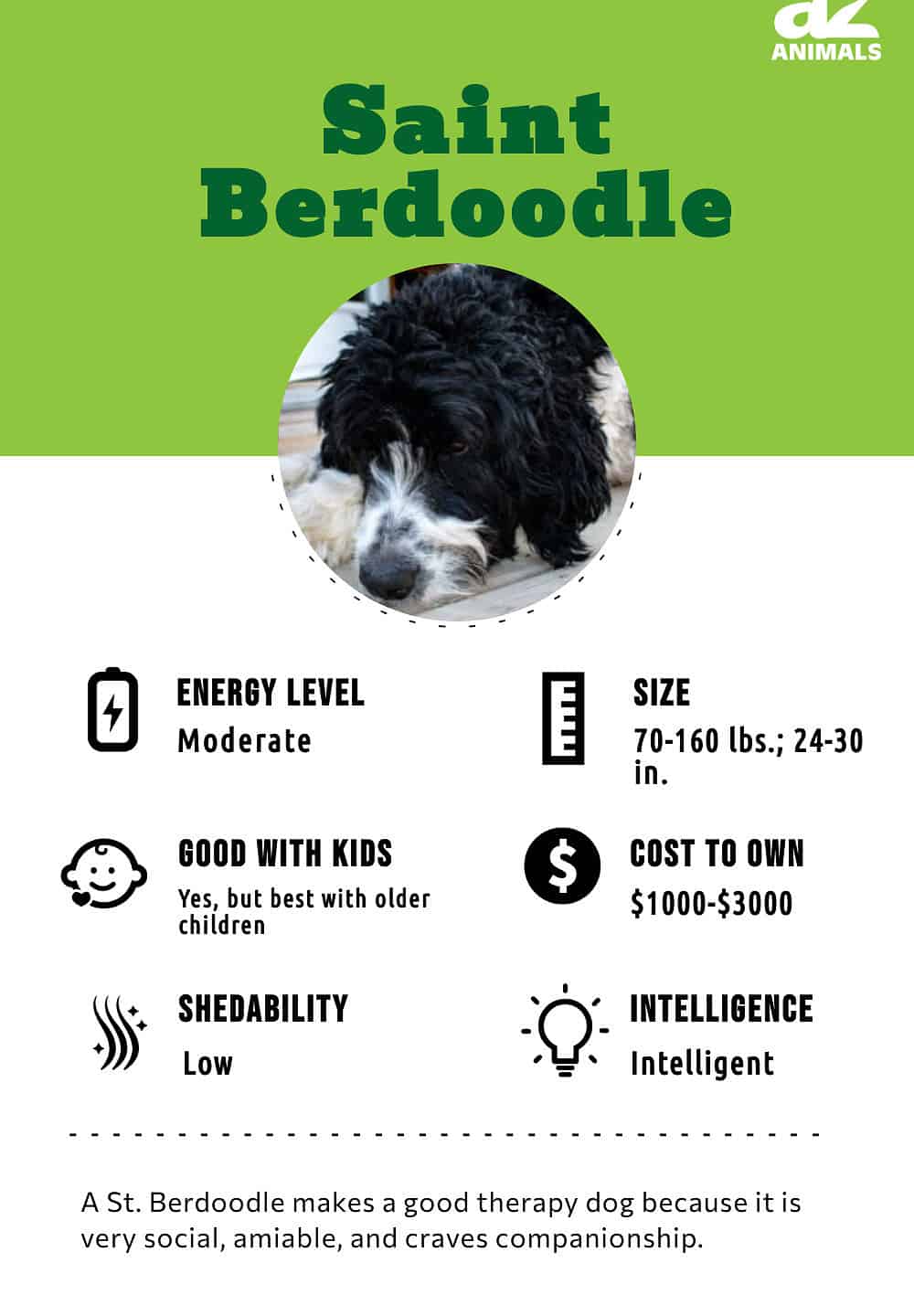Saint Berdoodle
Advertisement
Saint Berdoodle Scientific Classification
- Kingdom
- Animalia

Saint Berdoodle Facts
- Diet
- Omnivore
Saint Berdoodle Physical Characteristics
View all of the Saint Berdoodle images!
Saint Berdoodles are very playful dogs that are loyal, friendly, and smart, and enjoy activities with their families.

The Saint Bernard and the Poodle were bred to create the Saint Berdoodle. Also called the Saint Berpoo, St. Berpoo, St. Berdoodle, and Saint Bernard and Poodle Mix, this mixed breed has created wonderful companion dogs. They are loyal, friendly, and smart. A Saint Berdoodle can make a great addition to any home, even those with children. However, because of its size, it may be best suited for homes with older children.
See all of our expert product reviews.
St. Berdoodles are gaining popularity as a companion dog and are sought after for therapy dogs because of their very amiable personality.
3 Pros and Cons of Ownership
| Pros | Cons |
| Friendly: Saint Berdoodles are a very friendly and social breed. | Large: Saint Berdoodles are a very large breed and will need a lot of food and more space than smaller breeds. |
| Low shedding: Poodles are hypoallergenic and make up half of the genes of a St. Berpoo, so many don’t shed very much. | Prone to separation anxiety: Saint Berdoodles don’t like being left alone. They can become destructive, bark excessively, or engage in other undesirable behaviors if they’re left alone for too long. |
| Playful: Saint Berdoodles are a very playful breed and enjoy activities with their families. | Short lifespan: Saint Bernard and Poodle mixes have a shorter lifespan than some other breeds. |

Saint Berdoodles are a very large breed, weighing between 70 and 160 pounds.
©Hagars/Shutterstock.com
Size and Weight
These dogs are the largest of all the Doodle breeds. They typically weigh between 70 and 160 pounds and can be between 24 and 30 inches taller. Males are typically a bit taller and heavier than females. Occasionally, a Saint Bernard may be bred with a Mini Poodle to create a Mini St Berdoodle, but in most cases, St Berpoos are the result of a Saint Bernard being bred with a Standard Poodle.
The puppies will grow quickly. Within their first week, they typically double their birth weight of 1-1.5 lbs. By the time they are two months old, they’ll already weigh as much as 15 pounds. They will be fully grown by the time they are two years old.
Health and Entertainment for your Saint Berdoodle
- The Best Dog Food for Labrador Retrievers (Senior, Puppy, and Adult)
- Best Dog Food for Dogs With Diarrhea (Senior, Adult, and Puppy) — Reviewed and Ranked
- The Best Wholehearted Dog Food: Reviewed and Ranked
- Victor Performance Dog Food: Recalls, Pros, Cons, and More
- Royal Canin Bulldog Dog Food Review: Pros, Cons, Recalls
See all of our expert product reviews.
| Height (Male): | 24 inches to 30 inches |
| Height (Female): | 24 inches to 30 inches |
| Weight (Male): | 70 pounds to 160 pounds |
| Weight (Female): | 70 pounds to 160 pounds |
Common Health Issues
Most of this variety is overall very healthy. There are, however, a few common health concerns for this breed.
Saint Berdoodles may develop hip or elbow dysplasia. These are conditioners where the hip or elbow joints don’t develop correctly and the bones rub against one another. They can be quite painful for dogs and may require surgery to fix.
Degenerative myelopathy is another potential concern for this breed. This is a spinal disease that may eventually lead to paralysis.
St Berdoodles may also suffer from bloat. Bloat is a condition where the stomach fills with air and twists. Dogs are unable to get any gas out and will have a visibly bloated stomach. Head straight to an emergency vet if you suspect your dog has bloat as it can be life-threatening.
In summary, a few potential health concerns for the Saint Berdoodle include:
- Hip dysplasia
- Elbow dysplasia
- Bloat
Temperament and Behavior
These dogs have an extremely friendly personality. They are very social and love playing. They are also very affectionate. Their traits make them a great family dog (with older children they can’t accidentally injure).
As a social dog, these dogs crave attention and companionship. They do not like being left alone and may develop separation anxiety or engage in destructive behaviors or excessive barking if left alone for too long.
Care
Keep the temperament and potential health concerns of a Saint Berdoodle that were outlined above in mind as you prepare to care for your new pup. The dietary needs, grooming needs, and exercise needs of these dogs should also be factored in as you create your care plan.
Food and Diet
These dogs require high-quality large breed food. Ideally, select one formulated for dogs with a moderate energy level, however if your pet ends up with higher or lower energy levels based on their specific mix of genes, you may need to modify your selection.
As a very large dog, a Saint Berdoodle requires a large quantity of food. They should eat between 4 and 10 cups each day. This is such a large range because each St. Berpoo’s needs are different and the right amount of food will depend on its age, activity level, weight, health, metabolism and more. Split the total amount of food into two meals each day.
St Berdoodle puppies should be fed large-breed puppy food. They have a much smaller stomach than their adult counterparts and can’t eat too much food at one time. Split the total recommended amount of food for the puppy into three to four meals when they are under six months. Once they turn six months, switching to just two feeds a day is sufficient. Your dog’s vet can be a great resource if you need assistance selecting the right food or determining the appropriate quantity for your pup.
Maintenance and Grooming

Since the St. Bernard is one of the parents of a Saint Berdoodle, the offspring might get a similar coat and coloring.
©Rita_Kochmarjova/Shutterstock.com
Since a Saint Berdoodle’s coat can vary based on whether the Poodle or Saint Bernard genes are more dominant, the grooming it requires will also vary. Many dogs of this variety have a long and full coat with loose curls. They generally have a double coat and are moderate shedders, though some may have stronger Poodle genes to make them a hypoallergenic dog that rarely sheds.
A Saint Berdoodle will need to be brushed multiple times a week to remove dirt, debris, and loose hair. Regular brushing will also help spread the natural oils on the coat for improved coat health and shine, while also making sure the hair doesn’t get tangled. A slicker brush is typically the best option for this variety.
After brushing your pet, you should also brush its teeth to remove plaque and tartar and decrease the chance of it developing dental disease. Its ears will need to be checked regularly and kept clear of dirt and debris. You should also make sure your St. Berdoodle’s nails don’t get too long as it can make it uncomfortable or even painful for the dog to walk.
Training
These dogs are pretty easy to train thanks to their high intelligence and eager-to-please personality. Starting training from an early age is important to help your dog learn to follow commands. Also, training early will mean your dog is easier to manage since it won’t yet be so large. Positive training methods work best with this breed. You’ll also need to be sure to socialize your dog from an early age so it learns how to act in different situations and with different people or animals.
Exercise
These dogs require daily exercise. You should plan to take your dog for a long walk each day and provide it with opportunities to run and play around in a fenced-in yard or at a dog park. Since these dogs are so large, their energy level isn’t as high as some other breeds.

St Berdoodles start out as 1-pound puppies but grow rapidly into very large dogs.
©Hagars/Shutterstock.com
Puppies
Before bringing home a St Berdoodle puppy, talk with the breeder to find one with a personality that will best suit your home. If finding a hypoallergenic St Berdoodle is important to you, a breeder should also be able to offer suggestions for which pups are less likely to shed.
Prepare your home for the arrival of your new puppy by purchasing the food and other supplies the dog will need and finding a veterinarian you trust with its care. You should create a safe space for the puppy to play and relax by removing anything potentially dangerous or that you wouldn’t want destroyed by a playful puppy.
Children
This breed can make a wonderful addition to homes with older children. They are loyal, friendly, and playful. Since they are so large, they could inadvertently hurt a small child trying to play around with them. For this reason, Saint Berpoos are probably best for a home with older children.
Even though they are good with children, you should always supervise kids who are with your dog. This will prevent an accidental injury to the dog or child.
Similar Dogs
Saint Bernards, Poodles, and Sheepadoodles are three breeds that are similar to the Saint Berdoodle.
- Saint Bernard: Half of a Saint Berdoodle’s genes come from the Saint Bernard, so these two breeds are pretty similar. Both breeds are very affectionate, social, and good with children and other dogs. Saint Berdoodles are more intelligent and more playful than Saint Bernards.
- Poodle: Poodles also contribute half of a Saint Berdoodle’s genes. Both breeds are very intelligent, affectionate, and social. Poodles are smaller than Saint Berdoodles, though. They generally weigh between 45 and 70 pounds compared to the 70- to 160-pound weight of a Saint Berdoodle.
- Sheepadoodle: Sheepadoodles and Saint Berdoodles both have one parent that is a poodle. Both of these breeds are very friendly and can make a good family dog. They are smaller than Saint Berdoodles, though. Sheepadoodles typically weigh between 45 and 80 pounds while Saint Berdoodles weigh between 70 and 160 pounds.
Saint Berdoodle vs Bernedoodle

A Standard Poodle is one of the parents of both the Saint Berdoodle and the Bernedoodle.
©everydoghasastory/Shutterstock.com
While their names sound similar, Saint Berdoodles and Bernedoodles are two different breeds. However, both are mixed breeds that have one Poodle parent. St. Berdoodles are a mix between a Poodle and a Saint Bernard, while Bernedoodles are a mix between a Poodle and a Bernese Mountain Dog. Both breeds are very friendly, social, and intelligent. The St. Berdoodles are larger than Bernedoodles. They can weigh up to 160 pounds compared to the 90-pound max for most Bernedoodles. While Bernedoodles are black, white, and/or brown in color, Saint Berdoodles may also have cream, apricot, blue, silver, or gray coats.
Famous
Saint Berdoodles are gaining popularity, but there currently aren’t any celebrity owners. However, there are a few semi-famous varieties on Instagram that you can follow to learn more about this breed.
- Pitch is a Saint Berdoodle with a Corgi sister on Instagram. Pitch has over 17,000 followers.
- Murrie is a Saint Berdoodle with nearly 3,000 followers. Murrie lives in Chicago and his owners love sharing photos showcasing his fun personality.
- Rosie is a Saint Berdoodle with almost 1,000 followers. Her owners like dressing her up for different holidays and sporting events.
Popular Names
Need to find the right name for your St Berdoodle? Read through our list of suggestion below.
- Beethoven
- Teddy
- Maximus
- Berny
- Clifford
- Eva
- Bonnie
- Cuddles
- Cleo
- Lana
Saint Berdoodle FAQs (Frequently Asked Questions)
How much does a Saint Berdoodle cost to own?
The price to purchase a Saint Berdoodle from a breeder can vary. They may cost anywhere from $1,000 to $3,000 depending on the breeder’s reputation, the location, and a variety of other factors. It is also possible that you may be able to find a Saint Berpoo to adopt through a rescue organization. This will be significantly less expensive, and you should expect to pay just a few hundred dollars to cover application fees and vaccinations.
The price to purchase a St. Berdoodle from a breeder or adopt one from a rescue organization is just one of the things you should consider when thinking about how much this breed will cost to own. Saint Berdoodles are large dogs and will require a lot of food, which can really add up. You’ll also need to have money to cover veterinary bills, training, and other supplies your dog will need around the house. Since you’ll need to purchase all the necessities for your pup the first year you own him, expect this year to be the most expensive. You should be prepared to spend at least $1,000 to $1,500. Each of the subsequent years owning the dog will be a bit less expensive, but you still should be prepared to spend between $500 and $1,000.
Is a Saint Berdoodle good with kids?
Yes, Saint Bernard and Poodle mixes are very good with children. They are friendly, affectionate, and playful. However, due to their very large size, and Saint Berdoodle could accidentally injure a very small child trying to play with them, so they are probably best suited for homes with older children.
How long does a Saint Berdoodle live?
The average lifespan of a Saint Berdoodle is between 8 and 12 years.
How big does a Saint Berdoodle get?
As the largest of the Doodle breeds, Saint Berdoodles can get quite large. They typically weigh between 70 and 160 pounds and are between 24 and 30 inches tall.
How do you groom a Saint Berdoodle?
Saint Berdoodles will need to be brushed multiple times each week to keep their hair from getting tangled and remove dirt and dead hairs. Depending on the exact coat of your dog, you may opt to seek help from a professional groomer.
What is a Saint Berdoodle?
A Saint Berdoodle is a mixed breed dog that is a cross between a Poodle and a Saint Bernard. They are very large dogs that can weigh up to 160 pounds. Despite their almost intimidating size, Saint Berdoodles are actually quite friendly and can make a nice addition to homes with older children. They also can get along well with other dogs.
Do Saint Berdoodles shed?
Many Saint Berpoos are moderate shedders. However, some inherit more of a Poodle’s genes and may not shed much at all.
Thank you for reading! Have some feedback for us? Contact the AZ Animals editorial team.
Sources
- dogtime.com, Available here: https://dogtime.com/dog-breeds/saint-berdoodle#/slide/1
- petguide.com, Available here: https://www.petguide.com/breeds/dog/saint-berdoodle/
- loveyourdog.com, Available here: https://www.loveyourdog.com/saint-berdoodle/
- saint-berdoodles.com, Available here: https://www.saint-berdoodles.com/
- dogell.com, Available here: https://dogell.com/en/compare-dog-breeds/st-bernard-vs-saint-berdoodle-vs-great-pyrenees
- dogell.com, Available here: https://dogell.com/en/compare-dog-breeds/saint-berdoodle-vs-poodle-vs-st-bernard
- thedogsjournal.com, Available here: https://thedogsjournal.com/standard-bernedoodle-vs-saint-berdoodle-a-quick-comparison/#:~:text=Standard%20Bernedoodle%20is%20a%20product,most%20likely%20from%20the%20Poodle.
- thedogsjournal.com, Available here: https://thedogsjournal.com/standard-bernedoodle-vs-saint-berdoodle-a-quick-comparison/#:~:text=Standard%20Bernedoodle%20is%20a%20product,most%20likely%20from%20the%20Poodle.
- instagram.com, Available here: https://www.instagram.com/saintmurrie/?hl=en
- instagram.com, Available here: https://www.instagram.com/pitchthedog/?hl=en















